
| Palaeos |  |
Sphenodontia |
| Vertebrates | Sphenodontidae |
| Page Back | Unit Home | Unit Dendrogram | Unit References | Taxon Index | Page Next |
| Unit Back | Vertebrates Home | Vertebrate Dendrograms | Vertebrate References | Glossary | Unit Next |
|
Abbreviated Dendrogram
LEPIDOSAUROMORPHA |--SQUAMATA | `--o Rhynchocephalia |--Gephyrosaurus `--Sphenodontidae |--o Clevosauridae | |--Polysphenodon | `--+-- Brachyrhinodon | `-- Clevosaurus `--o Stem Group Sphenodontinae |-- Homoeosaurus |--Pleurosauridae `--+--Sphenodontinae `--+--Sphenodontini `--Eilenodontini |
Contents
Overview |
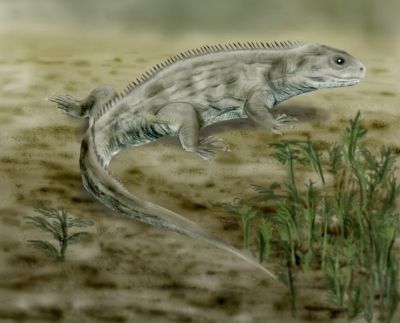 |
| Brachyrhinodon taylori, a clevosaur from the Late Triassic of Scotland; artwork by Nobu Tamura, Wikipedia |
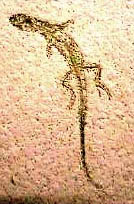 Sphenodontidae:
Kallimodon, Homoeosaurus, Sapheosaurus, Pamizinsaurus.
Sphenodontidae:
Kallimodon, Homoeosaurus, Sapheosaurus, Pamizinsaurus.
Range: from the Late Triassic.
Phylogeny: Sphenodontia : Diphydontosaurus + (Planocephalosaurus + * : Clevosauridae + Stem Group Sphenodontinae).
Characters: VS-M size. See Clevosaurs entry for basic skull structure. $ Teeth fused to jaw margin (fully acrodont) and not replaced; less than 4 (7?) premaxillary teeth; $ marginal teeth added posteriorly as jaw grows; dentary fits between maxillary teeth and parallel row of palatal teeth; Meckelian canal runs along midline of jaw & is at least partially open; broad mandibular symphysis; prominent coronoid process of dentary, posterior process of dentary ends posterior to coronoid; with posterior surangular facet; frontals not fused (??); $ lacrimal absent; large upper temporal fenestra; complete lower temporal bar; quadratojugal retained; rigid quadrate; well-developed posterior tubercle on posterior margin of ischium; epiphyses present with determinate growth; may have osteoderms (Pamizinsaurus); food crushed thoroughly (insects & birds).
Comments: Cladistically, this taxon (equivalent to the standard Linnean taxonomic Sphenodontidae) should perhaps be called something like Sphenodontoidea, as it includes Clevosauridae, Pleurosauridae,. Crown Group Sphenodontidae, etc
Links: Introduction to the Sphenodontidae; Turtle, Tuatara, Crocodile Checklist--3; Jurassic Page´s gallery : the terrestrial wildlife (Sapheosaurus); Lebende Fossilien, Intro, Teil 2 (Homoeosaurus).
References: Evans & Sigogneau-Russell (1997); Reynoso (1996); Reynoso (1997); Reynoso & Clark (1998).
Image: Kallimodon (among a very good collection of fossil photos) from Herbert Krause. Reproduced by permission.
Note: The nomenclature of sphenodont taxa tends to be rather confused. The scheme used here is adopted from the sensible system of Mikko Haaramo, who credits Wu, X-C (1994), Late Triassic - Early Jurassic sphenodontians from China and the phylogeny of the Sphenodontia, in Fraser, NC & H-D Sues (eds.), In the Shadow of the Dinosaurs, Cambridge Univ. Press. ATW001117.
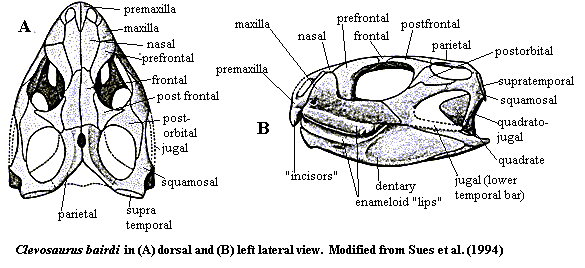 Clevosaurs/Clevosauridae : Brachyrhinodon, Clevosaurus. Clevosaurus > Sphenodon?
Clevosaurs/Clevosauridae : Brachyrhinodon, Clevosaurus. Clevosaurus > Sphenodon?
Range: Early Jurassic to Early Cretaceous(?).
Phylogeny: Sphenodontidae : Stem Group Sphenodontinae + *.
Characters: 1 or more robust "incisor" teeth forming chisel edge ankylosed to premaxilla; palatine dentition; marginal dentition acrodont or absent; shearing (not crushing or piercing) bite with simple orthal (up-and-down) jaw motion; $ long thin posterior process of premaxilla excludes maxilla from margin of nares; $ lacrimal absent; may have dentine "lips"; $ antorbital skull very short (<25% of total skull); triradiate postfrontal broadly contacts frontal; complete lower temporal bar formed by jugal loosely contacting slim quadratojugal; $ dorsal process of jugal elongate; $ large (> 25% skull length) lower temporal fenestra; gap between jugal and quadratojugal small; proximal caudal vertebrae have large transverse processes; caudal autotomy septa may be present distally; humerus strongly bent and expanded at both ends; femur gently S-shaped.
Note: For reasons I have not been able to determine, no one seems to have gotten around to giving this group a Latinized family name. ATW. Update: this has now been rectified. On the basis of new material Arantes et al 2009 formalises the family Clevosauridae, composed of Clevosaurus, Brachyrhinodon and Polysphenodon. MAK101016
Links: Diapsida; Clevosaurus bairdi (but server is frequently reduced or absent!); Autapomorphies of diapsid clades; Untitled Document; Lecture 12 - Early Jurassic.
References: Reynoso (1996); Reynoso & Clark (1998); Sues et al. (1994). ATW
Range: Middle Keuper (Early Norian) of Hannover, W Germany
Phylogeny: Clevosauridae : (Brachyrhinodon + Clevosaurus ) + *.
Characters: short snout like Brachyrhinodon, multiple rows of teeth on the palate. It shows sphenodontian characters such as a groove between the maxilla and palatine for the dentary
Comments: Known from a partial skull and skeleton. The only known specimen went missing in the 1930s, but a number of casts and plaster moulds are available (Fraser & Benton 1989 p.416. )
 |
| Brachyrhinodon taylori, skull in ventral (A), dorsal (B) and lateral (C) view. From Fraser & Benton 1989 p.416. Scale bar 1 cm. Note palatal teeth in (A); teeth on the upper palate (roof of the mouth) are a primitive feature found in most basal amniotes |
Brachyrhinodon: Brachyrhinodon taylori
Range: Late Carnian of Elgin, Scotland;
Phylogeny: Clevosauridae : Polysphenodon + (Clevosaurus + *).
Characters: small (c. 15 cm long), short-snouted skull with premaxillary beak. Benton 1985
Comments: One of the earliest known sphenodontians
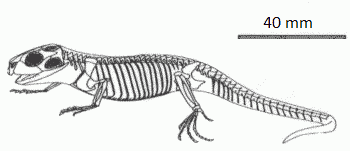
Synonyms: Asiacephalosaurus; Rarojugalosaurus; Dianosaurus
Range: Late Triassic to Early Jurassic. WEu. ENAm. EAs, S Am
Phylogeny: Clevosauridae : Polysphenodon + (Brachyrhinodon + *).
Comments: a very successful and widespread, species-rich genus
Links: Wikipedia
Graphic: From Fossil Reptiles of Great Britain
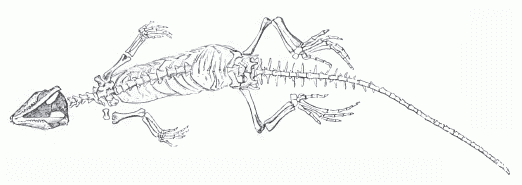 |
| Kallimodon pulchellus (Zittel), 1887. Late Jurassic; Kelheim, Bavaria. Ventral aspect. From Zittel/Eastman/Woodward 1902 p.151. This represents a type similar to or intermediate between Homoeosaurus and Sapheosaurus |
Stem Group Sphenodontinae: here used to mean Sphenodon > Clevosaurus
Range: from the Early Jurassic
Phylogeny: Sphenodontoidea : Clevosaurinae + * : Homoeosaurus + Pleurosauridae + (Sapheosaurus + Sphenodontinae).
Characters: Vertebrae amphicoelous, sometimes with persistent notochord; intercentra present in cervical (neck) and caudal (tail) regions. External nares separated ; interclavicle T-shaped; dermal scales subrectangular. Greatiy enlarged postfrontal bone extending far posteriorly (to the rear) on parietal. Except for a few teeth on the vomer in juveniles and the palatine row, all other palatal teeth absent (i.e. teeth on the roof of the mouth, in contrast to primitive amniotes). Premaxillae each with a small pointed tooth. A single series of enlarged, depressed, triangular, acrodont teeth present on maxillae, mandibles, and outer edge of the palatines; vomer toothless. pattern of tooth wear facets, tooth ultrastructure, and anteroposterior length of the mandibular articulation, all of which indicate development of the propalinal masticatory movements (front to rear chewing) as with the Recent Sphenodon Zittel/Eastman/Woodward 1902, Gauthier et al 1988 p.25
Comments: replaced the Clevosaurs in the middle and late Jurassic
Homaeosaurus: v. Meyer
Range: Kimmeridgian (Lithographic Stone) of Bavaria, and Cerin, France. Kimmeridgian of Hanover, and Purbeckian (Tithonian) of England.
Phylogeny: Stem Group Sphenodontinae : Pleurosauridae + (Sapheosaurus + Sphenodontinae) + *.
Characters: From Zittel/Eastman/Woodward 1902 (copyright expired): "Attaining a length of between 20 and 40 cm., and differing from the recent Sphenodon in that intercentra are absent between the dorsal vertebrae ribs without uncinate processes, and humerus not pierced by entepicondylar foramen. Mandibular rami united at the symphysis by ligaments ; second sacral rib bifid distally." applies also to Sapheosaurus and Kallimodon Gauthier et al 1988 p.26: Compared to sphenodontines and sapheosaurs, Homoeosaurus is distinguished by smaller size, gracile and elongate limbs, and a broad parietal table (skull roof above the orbits (eye holes)), all of which, with the possible exception of the limb proportions, are plesiomorphic (shared ancestral) features.
Comments: highly lizard-like forms.
Links: Wikipedia (not much text but some nice photos)
| Page Back | Unit Home | Page Top | Page Next |
Using this material. All material by ATW is public domain and may be freely used in any way (also any material jointly written by ATW and MAK). All material by MAK is licensed Creative Commons Attribution License Version 3.0, and may be freely used provided acknowedgement is given. All Wikipedia material is either Gnu Open Source or Creative Commons (see original Wikipedia page for details). Other graphics are copyright their respective owners